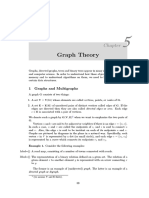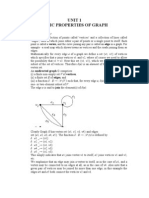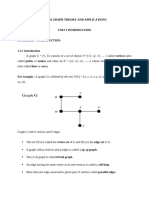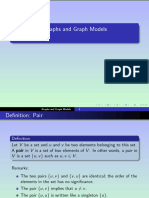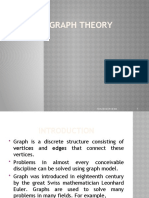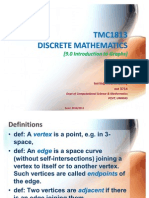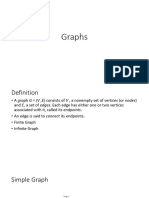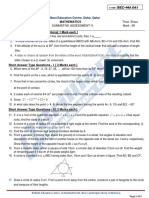Introduction To Graph Theory
Introduction To Graph Theory
Uploaded by
ClarawohonCopyright:
Available Formats
Introduction To Graph Theory
Introduction To Graph Theory
Uploaded by
ClarawohonOriginal Description:
Original Title
Copyright
Available Formats
Share this document
Did you find this document useful?
Is this content inappropriate?
Copyright:
Available Formats
Introduction To Graph Theory
Introduction To Graph Theory
Uploaded by
ClarawohonCopyright:
Available Formats
CHAPTER 6
Introduction to Graph Theory
1. Introduction to Graphs
1.1. Simple Graphs.
Definition 1.1.1. A simple graph (V, E) consists of a nonempty set representing vertices, V , and a set of unordered pairs of elements of V representing edges, E.
A simple graph has
no arrows,
no loops, and
cannot have multiple edges joining vertices.
Discussion
Graphs offer a convenient way to represent various kinds of mathematical objects.
Essentially, any graph is made up of two sets, a set of vertices and a set of edges.
Depending on the particular situation we are trying to represent, however, we may
wish to impose restrictions on the type of edges we allow. For some problems we will
want the edges to be directed from one vertex to another; whereas, in others the edges
are undirected. We begin our discussion with undirected graphs.
The most basic graph is the simple graph as defined above. Since the edges of
a simple graph are undirected, they are represented by unordered pairs of vertices
rather than ordered pairs. For example, if V = {a, b, c}, then {a, b} = {b, a} would
represent the same edge.
Exercise 1.1.1. If a simple graph G has 5 vertices, what is the maximum number
of edges that G can have?
1.2. Examples.
Example 1.2.1. V = {v1 , v2 , v3 , v4 } E = {{v1 v2 }, {v1 , v3 }, {v2 , v3 }, {v2 , v4 }}
178
1. INTRODUCTION TO GRAPHS
v1
v2
v3
v4
179
Example 1.2.2. V = {a, b, c}, E = {{a, b}, {b, c}, {a, c}}
1.3. Multigraphs. Definition: A multigraph is a set of vertices, V , a set of
edges, E, and a function
f : E {{u, v} : u, v V and u 6= v}.
If e1 , e2 E are such that f (e1 ) = f (e2 ), then we say e1 and e2 are multiple or
parallel edges.
Example 1.3.1. V = {a, b, c, d}, E = {e1 , e2 , . . . , e6 }, f : E {{u, v} : u, v
V and u 6= v} is defined as follows.
e
e1
e2
e3
e4
e5
e6
f (e) {a, c} {a, c} {a, b} {c, b} {b, d} {b, d}
1. INTRODUCTION TO GRAPHS
e3
e2
e1
180
e4
e6
e5
c
Discussion
In Example 1.3.1 e1 and e2 are parallel edges, but the edges e2 and e5 are not
called parallel edges.
Exercise 1.3.1. Find all the parallel edges Example 1.3.1.
Notice that a multigraph allows for multiple edges between a pair of vertices, but
does not allow for loops. In some applications it may be desirable to illustrate all
the connections between the vertices. Say for example, in a network there may be
multiple wires connecting the same units.
1.4. Pseudograph.
Definition 1.4.1. A pseudograph is a set of vertices, V , a set of edges, E, and
a function f : E {{u, v} : u, v V }. If e E is such that f (e) = {u, u} = {u},
then we say e is a loop.
Example 1.4.1. V = {a, b, c, d}, E = {e1 , e2 , . . . , e8 },
f : E {{u, v} : u, v V }
is defined as follows.
e1
e2
e3
e4
e5
e6
e7
e8
f (e) {a, c} {a, c} {a, b} {c, b} {b, d} {b, d} {a} {d}
1. INTRODUCTION TO GRAPHS
181
e7
b
e3
a
e2
e1
e6
e5
e4
d
e8
Discussion
The pseudograph adds the possibility of loops. For example, a diagnostic line may
be used in a network, which is a line connecting a computer to itself.
1.5. Directed Graph.
Definition 1.5.1. A directed graph (V, E) consists of a set of vertices, V , and
a set of directed edges, E. The elements of E are ordered pairs of vertices.
Example 1.5.1. V = {a, b, c, d},
E = {(a, c), (c, a), (a, b), (c, b), (b, d), (d, b), (a, a), (d, d)},
1. INTRODUCTION TO GRAPHS
182
e7
b
e3
a
e2
e1
e6
e5
e4
d
e8
Discussion
A directed graph, or digraph, allows loops and allows two edges joining the same
vertex, but going in the opposite direction. More than one edge going in the same
direction between vertices, however, is not allowed. A directed edge is defined by
an ordered pair rather than an unordered pair. That is, the ordered pair (a, b) is
different from the ordered pair (b, a), while the unordered pair {a, b} = {b, a}. Be
careful of the notation you use when writing an edge.
Exercise 1.5.1. If a directed graph G has 5 vertices, what is the maximum number
of (directed) edges of G?
1.6. Directed Multigraph.
Definition 1.6.1. A directed multigraph (V, E) consists of vertices, V , and
edges, E, and a function
f : E V V = {(u, v)|u, v V }.
The edges e1 and e2 are multiple edges if f (e1 ) = f (e2 )
Example 1.6.1. V = {a, b, c, d}, E = {e1 , e2 , . . . , e10 },
f : E {(u, v) : u, v V }
is defined as follows.
e1
e2
e3
e4
e5
e6
e7
e8
e9
e10
f (e) (a, c) (c, a) (a, b) (c, b) (b, d) (d, b) (a, a) (d, d) (a, b) (b, d)
1. INTRODUCTION TO GRAPHS
e7
e9
a
e2
e1
183
e3
e5
e4
e6
e10
c
d
e8
Discussion
Notice the difference between a directed graph and a directed multigraph: a directed graph allows more than one edge to connect the same two vertices as long as
they have opposite directions; whereas, no such restriction is placed on the edges of
a directed multigraph.
Exercise 1.6.1. Give all the multiple edges in Example 1.6.1.
1.7. Graph Isomorphism.
Definition 1.7.1. Let G1 = (V, E) and G2 = (U, F ) be simple graphs. The graphs
G1 and G2 are isomorphic if there exists a bijection
f: V U
such that for all v1 , v2 V , v1 and v2 are adjacent in G1 if and only if f (v1 ) and
f (v2 ) are adjacent in G2 .
Definition 1.7.2. If f is a bijection as described above, then f is called an isomorphism between G1 and G2 , and we often write
f : G1 G2 .
Discussion
There are several notations that are used to represent an isomorphism. We will
use a common notation G1 ' G2 to mean that G1 is isomorphic to G2 .
Trying to construct an isomorphism between graphs can be a very difficult problem
in general. If simple graphs G1 and G2 are isomorphic, then, clearly, they must have
1. INTRODUCTION TO GRAPHS
184
the same number of vertices. As the next exercise shows, G1 and G2 must also have
the same number of edges. Having the same number of vertices and edges,
however, is in no way sufficient for graphs G1 and G2 to be isomorphic.
Often to prove existence of an isomorphism between two graphs one must actually
construct the isomorphism.
Exercise 1.7.1. Prove that if simple graphs G1 and G2 are isomorphic, then G1
and G2 have the same number of edges.
Example 1.7.1. The graphs G1 and G2 below are isomorphic. The bijection is
defined by f (vi ) = ui .
v1
v4
v2
G1
v3
u1
u2
u3
u4
G2
Example 1.7.1 illustrates a situation in which it is very easy to construct an
isomorphism. The graph G2 is merely an alteration of G1 obtained by moving one of
the edges so it goes around rather than crossing over another edge and relabeling its
vertices.
One way to visualize when two graphs are isomorphic is to imagine that all the
vertices are beads and each edge is represented by a sting with each end tied to the
beads that represents its endpoints. If you pick one or more beads up and place it in
another location without untying the strings, you obtain a graph that is isomorphic
to the original. In fact, if you can move the vertices to different positions keeping
the edges attached to go from one graph to another, the two graphs are isomorphic.
Edges are allowed to pass through each other, so a straight edge and a knotted
edge would be considered the same edge.
When two graphs are isomorphic, they share many of the important properties
of graphs. In many instances we do not differentiate between two graphs that are
1. INTRODUCTION TO GRAPHS
185
isomorphic. Until we study isomorphism in detail, we will not differentiate between
two isomorphic graphs. We will discuss graph isomorphisms further in Module 6.3.
Exercise 1.7.2. Construct a definition for isomorphism between
(a)
(b)
(c)
(d)
two
two
two
two
multigraphs.
pseudographs.
directed graphs.
directed multigraphs.
You might also like
- 1315 - Maxwell Doe List - Unseal Order - Dec 2023Document51 pages1315 - Maxwell Doe List - Unseal Order - Dec 2023Techno Fog100% (2)
- BDO Audit Plan and ProgramDocument22 pagesBDO Audit Plan and ProgramRicart Von Laureta100% (1)
- Manual Lippke4500Document40 pagesManual Lippke4500Arkhano Jhoss Gio0% (1)
- King's Cross: The Story of The World in The Life of JesusDocument12 pagesKing's Cross: The Story of The World in The Life of JesusPaddy0% (3)
- Chapter 4 (Discrete Math)Document72 pagesChapter 4 (Discrete Math)Sura OGNo ratings yet
- Introduction To Graphs: Multigraph, Other Just Call A GraphDocument17 pagesIntroduction To Graphs: Multigraph, Other Just Call A GraphMaitreyee Abhisek SaikiaNo ratings yet
- Graph Theory ReadingDocument14 pagesGraph Theory ReadingSZNo ratings yet
- Cha5 Graph TheoryDocument10 pagesCha5 Graph Theoryham.karimNo ratings yet
- Block 2 Unit 1Document8 pagesBlock 2 Unit 1Fatema SingapurwalaNo ratings yet
- Chap 1Document60 pagesChap 1sekarsekar29737No ratings yet
- CS6702 Graph Theory and Applications Unit I IntroductionDocument25 pagesCS6702 Graph Theory and Applications Unit I Introductionsathvik aNo ratings yet
- s9.1 Graphs and ModelsDocument12 pagess9.1 Graphs and ModelsEngineer JONo ratings yet
- Graph Theory Notes by Vadim LozinDocument73 pagesGraph Theory Notes by Vadim LozinDmitry Krylov100% (1)
- Graph TheoryDocument456 pagesGraph TheoryRanjith M Kumar100% (2)
- Let Us Switch To A New Topic:: Graphs Graph TheoryDocument27 pagesLet Us Switch To A New Topic:: Graphs Graph TheoryAfiat Khan TahsinNo ratings yet
- Set Theory GraphsDocument33 pagesSet Theory GraphsKristine ManuelNo ratings yet
- Graph Terminology PDFDocument9 pagesGraph Terminology PDFPeter BandaNo ratings yet
- GraphsDocument19 pagesGraphsVashuNo ratings yet
- (Graph Theory) : Discrete Structure Tribhuvan University Kathmandu, NepalDocument44 pages(Graph Theory) : Discrete Structure Tribhuvan University Kathmandu, NepalSuman Thapa MagarNo ratings yet
- Unit 4 Graph Theory: Prepared By: Ramesh RimalDocument129 pagesUnit 4 Graph Theory: Prepared By: Ramesh RimalramnathNo ratings yet
- Week 11 - GraphsDocument11 pagesWeek 11 - GraphsEmmanuel GuillermoNo ratings yet
- Graphs and OptimizationDocument20 pagesGraphs and OptimizationAmira ZarglayounNo ratings yet
- DS Leceture 18Document9 pagesDS Leceture 18mtalhamalik998No ratings yet
- Graph Downloaded PresentationDocument99 pagesGraph Downloaded Presentationyosab52179No ratings yet
- 03. Graph TheoryDocument99 pages03. Graph TheorymirNo ratings yet
- Module NotesDocument19 pagesModule Notesg6xwsg27jfNo ratings yet
- Graph Theory For B.Sc. CSIT: Prajwal KansakarDocument49 pagesGraph Theory For B.Sc. CSIT: Prajwal KansakarSulav KhatiwadaNo ratings yet
- 1.1 Graph TheoryDocument8 pages1.1 Graph TheorySamah Sam BouimaNo ratings yet
- Lecture 14 - DMDocument6 pagesLecture 14 - DMMerei MuratovNo ratings yet
- Graph TheoryDocument32 pagesGraph TheoryRvprasadNo ratings yet
- Introduction To Graph TheoryDocument22 pagesIntroduction To Graph TheoryhenkjohanjorisdexNo ratings yet
- Graph 1Document5 pagesGraph 1zainsaeed4871No ratings yet
- Graph Theory Introduction L 1 PDFDocument18 pagesGraph Theory Introduction L 1 PDFbubunadefNo ratings yet
- DSLec 13Document28 pagesDSLec 13Hamayon WazirNo ratings yet
- Reader+5+ +Basics+of+Graph+TheoryDocument29 pagesReader+5+ +Basics+of+Graph+TheoryhenkjohanjorisdexNo ratings yet
- Graph TheoryDocument302 pagesGraph TheorysanthoshNo ratings yet
- 9.0 Graphs Full SetDocument63 pages9.0 Graphs Full SetFaiz RamliNo ratings yet
- Graph Theory Answer KeyDocument55 pagesGraph Theory Answer KeyNeeraj SinghNo ratings yet
- 00 PreliminariesDocument74 pages00 PreliminariesPulkitNo ratings yet
- Graph FinalDocument87 pagesGraph FinalVaidehi SutharNo ratings yet
- Graphs: Massachusetts Institute of Technology 6.042J/18.062J, Fall '02 Professor Albert Meyer Dr. Radhika NagpalDocument17 pagesGraphs: Massachusetts Institute of Technology 6.042J/18.062J, Fall '02 Professor Albert Meyer Dr. Radhika Nagpalshobhit007No ratings yet
- Graph Theory NotesDocument53 pagesGraph Theory Notesmazhar10325100% (1)
- Lecture Notes 1 - 4Document20 pagesLecture Notes 1 - 4Malik ShaanNo ratings yet
- Unit Vi GraphDocument68 pagesUnit Vi Graphdnyaneshwarpande60No ratings yet
- fe9a1c29-3bdb-4273-82e3-3f0ff5815757Document73 pagesfe9a1c29-3bdb-4273-82e3-3f0ff5815757aya16235No ratings yet
- 2 Fundamentals: Ulrik Brandes and Thomas ErlebachDocument9 pages2 Fundamentals: Ulrik Brandes and Thomas Erlebachmorgoth12No ratings yet
- 4. Graph TheoryDocument29 pages4. Graph Theorykushgohel86No ratings yet
- 2 Data Structures NotesDocument14 pages2 Data Structures Notesmanasaggarwal1107No ratings yet
- Chapter 5 - GraphsDocument14 pagesChapter 5 - Graphstrevorsum123No ratings yet
- Bipartite Graphs and Problem SolvingDocument8 pagesBipartite Graphs and Problem SolvingNikita MishraNo ratings yet
- Graph Theory: IntroductionDocument5 pagesGraph Theory: IntroductionMinani Jean BaptisteNo ratings yet
- Graphs - Discrete MathematicsDocument17 pagesGraphs - Discrete MathematicsCarlos Cano MuñozNo ratings yet
- Discrete Mathematics Lecture Note (Chapter 4)Document60 pagesDiscrete Mathematics Lecture Note (Chapter 4)Gemechis GurmesaNo ratings yet
- Graphs and Gates Exam EditionDocument15 pagesGraphs and Gates Exam Editionimmyimmaculate296No ratings yet
- Definition: A Graph G Is Any Network of Points and Lines. We Usually Call TheDocument3 pagesDefinition: A Graph G Is Any Network of Points and Lines. We Usually Call TheJinto A JNo ratings yet
- Graph Theory Notes Module 5Document69 pagesGraph Theory Notes Module 5bibliophileonthesamepageNo ratings yet
- Lecture 8 MTL180Document53 pagesLecture 8 MTL180Mayank JhaNo ratings yet
- Unit 5Document14 pagesUnit 5phanishekarreddy116No ratings yet
- Graph TheoryDocument50 pagesGraph Theorykobby klausNo ratings yet
- Topic 5 Lecture Notes (Gardiner)Document74 pagesTopic 5 Lecture Notes (Gardiner)tonyho2003No ratings yet
- Graph Theorychap4Document112 pagesGraph Theorychap4snehasispal.spNo ratings yet
- Notes 943 Unit4 GraphsDocument58 pagesNotes 943 Unit4 Graphskewep39969No ratings yet
- H 100 ManualDocument262 pagesH 100 ManualMurat CanNo ratings yet
- Englist TestDocument6 pagesEnglist TestRifanNo ratings yet
- OkstraGrunderwerb deDocument12 pagesOkstraGrunderwerb desaifullahbhuttaNo ratings yet
- Complex Calculators in The Classroom Theoretical and Practical Teaching in Pre-CalculusDocument25 pagesComplex Calculators in The Classroom Theoretical and Practical Teaching in Pre-CalculusJonel RuleNo ratings yet
- Inquiry Unit Planning TemplateDocument4 pagesInquiry Unit Planning TemplateToniNo ratings yet
- History Lesson 4Document3 pagesHistory Lesson 4nichole.a gnNo ratings yet
- Mr. Abdurahiman Kundil 18782SA2-Set-MA041 (2017-03)Document2 pagesMr. Abdurahiman Kundil 18782SA2-Set-MA041 (2017-03)newtonfogg123No ratings yet
- Contact Lens-Induced Limbal Stem Cell Deficiency - EyeWikiDocument4 pagesContact Lens-Induced Limbal Stem Cell Deficiency - EyeWikiSania NadianisaNo ratings yet
- OAF CO ExtensionDocument3 pagesOAF CO ExtensionBhargi111No ratings yet
- Disability Action PlanDocument29 pagesDisability Action PlanVishal SolankiNo ratings yet
- Moot Court CompetitionDocument4 pagesMoot Court CompetitionKonark RajNo ratings yet
- 4-Introduction To AudacityDocument22 pages4-Introduction To AudacityNoor HidayahNo ratings yet
- ODI 4 Test Unit 5-6Document2 pagesODI 4 Test Unit 5-6SilvanaNo ratings yet
- ACH 4106 Physical Chemistry IDocument4 pagesACH 4106 Physical Chemistry IHellenNo ratings yet
- Ethnography/Participants Observation: Dr. Sadia MalikDocument21 pagesEthnography/Participants Observation: Dr. Sadia MalikmuqadusNo ratings yet
- Coordinating Conjunctions Worksheet: Comma SplicesDocument2 pagesCoordinating Conjunctions Worksheet: Comma SplicesAlvin OcampoNo ratings yet
- Fault Tolerant Systems: Chapter 1: PRELIMINARIESDocument14 pagesFault Tolerant Systems: Chapter 1: PRELIMINARIESKisalay KumarNo ratings yet
- AndhraPradesh DV List1Document4 pagesAndhraPradesh DV List1NAGA NIKHILNo ratings yet
- Explicit Instruction ModelDocument2 pagesExplicit Instruction ModelkatemcarthurNo ratings yet
- Harr Wavelet AnalysisDocument47 pagesHarr Wavelet AnalysisGaurav KhantwalNo ratings yet
- Print Eval - PHPDocument3 pagesPrint Eval - PHPAlthea Louise Santiago PalacNo ratings yet
- Inorganic Industries Engineering هيوضعلايرغ تاعانصلا ةسدنه: Dr.: Sameh Araby El-MekawyDocument37 pagesInorganic Industries Engineering هيوضعلايرغ تاعانصلا ةسدنه: Dr.: Sameh Araby El-MekawyMohamed AbdelaalNo ratings yet
- 1FK7 G2 Op Instr 1021 en-USDocument138 pages1FK7 G2 Op Instr 1021 en-USliqvidatortdNo ratings yet
- Final Photosynthesis Summative ReportDocument5 pagesFinal Photosynthesis Summative Reportapi-194618590No ratings yet
- Personal Grooming of PresenterDocument29 pagesPersonal Grooming of PresenterFouzan SoniwalaNo ratings yet
- ww07 Chem Feed WBDocument74 pagesww07 Chem Feed WBHouseNo ratings yet







